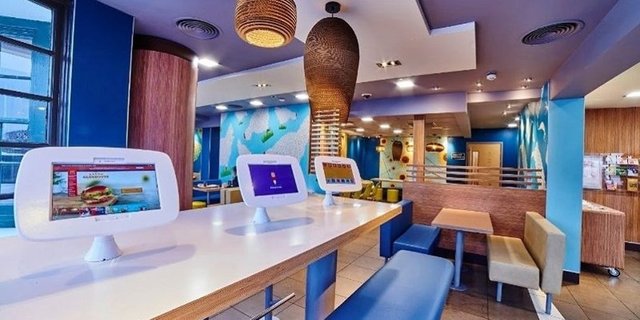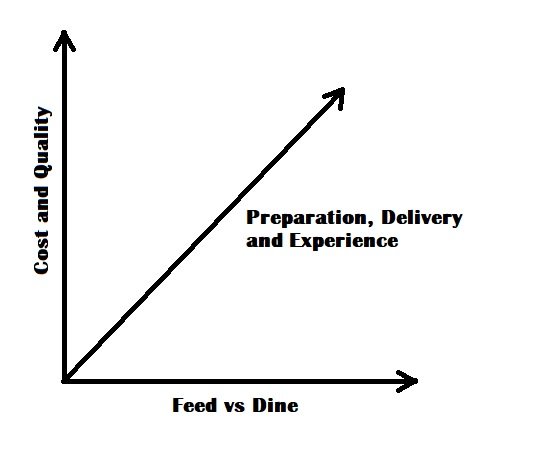The future of restaurants, what will it look like?

One thing we all like to do, and that is eat. Not just eat but have someone else make it - yes restaurants. Food and drinks sales of the restaurant industry in the United States reached $745.61 billion in 2015 – a long way from the $42.8 billion seen in 1970. Nearly a trillion-dollar industry, so it is a big deal. News Forecasters puts its crystal ball to work and provides a take on what the restaurant industry may look like in the future. The focus will be on the restaurant business, not specific new food ideas that may come about - we will leave this to others.
News Forecasters sees food services divided into two sectors. Those who want to feed and those who want to dine. This is not to say each customer does one or the other, rather the customer will choose their foodservice venue based on their "current context" of price, experience, and quality needs. Of course, this is not binary, rather a continuum.
The restaurant industry may segment into three types of basic restaurant service providers - food preparers, food delivery, and experience providers. Doing so will drive up the productivity and quality of service. Today, all three are being mostly done by a single company. For sure in some cases, this will continue, but the future customer will consider this industrialized food - undesirable. Small specialty niche restaurants will still exist, but their high cost will make them economically unrealistic for most. Think of it as a three-dimensional framework (see inset chart), where restaurant entrepreneurs will need to design and find their market space - properly selecting their service providers and then adding their specific intellectual property value ads to the restaurant framework.Both sectors of feeding and dinning will need to address all these "current context" issues. People that want to feed, want to satisfy an immediate human need of thirst and hunger. Diners want experience and good food. Typical feeders will want:
- Very low cost.
- Speed, location (whether at home or on the go), and ease of ordering and delivery.
- Some nice presentation is useful - but a tray, a bag, and a cup will do.
- Of course, a good cost to food quality ratio is paramount - but the customer understands they are not dining.
- Experience providers come in the form of the ease of order fulfillment, food courts, in-home, and specialized locations. Since preparation is centralized, the footprint of delivery locations will get smaller or combined into other location venues.
- Food preparers will continue to provide the fast food we, unfortunately, will continue to like. However, more variety and higher-end quality foods will make their way into this space. The change will occur in centralizing food preparation - even packaging, where possible.
- Food delivery gets dominated by Uber-like delivery to the home and highly specialized delivery locations in high traffic areas - for those on the go. Smartphone apps will provide technology logistics for ordering and fulfillment management.
Typical diners will want:
- A good cost to food quality ratio, being paramount.
- It is all about the customer experience - both in food preparation and delivery.
- The cost will be relative to the customer's perceived value.
- Experience providers will be one of the bigger growth areas in future restaurants - real estate developers and theme designers. The food court transforms into a restaurant theme park. The themes are endless - let your imagination run wild. From noisy kid gaming areas (ugh), singles crowd "cool" bar-restaurants (futuristic, trendy, country-western just to name a few) to the quiet sophisticated quite dinning (museums, historical, art just to name a few). The point here is that restaurant theme parks will provide for other interesting things to do and see while dining out. The cost of themes parks are expensive and hence a single restaurant theme park may have many restaurants food preparers within them.
- Food preparers give way to the chef - a good chef will become respected again as a real career. Quality food will finally make its way into the restaurant business as a mainstay. Under a new restaurant framework, the chef will be liberated from many of the restaurant management drudgeries and focus on one thing - food preparation!
- Food delivery, in the tradition of the counseling barman (and barwoman) and silver service, is coming back - food delivery services for the diner becomes impeccable and delightful once again. Trade schools may start-up to bring this career choice back. Experience providers may try to enter this space but probably is not a good idea. The two services are very different in terms of skills required. However, it may be conceivable that a single restaurant theme park with multiple food preparers, may have a single other specialized food delivery service provider.
People often ask, with new technology automation, where will the new jobs come from? If you see well (management, technology, designers and skilled service delivery work), with this new restaurant framework, costs will come down, obtain more customers with a better product - we will have more jobs not less, though you will need to be good at what you do. Happy eating!
A video presentation of this subject:
